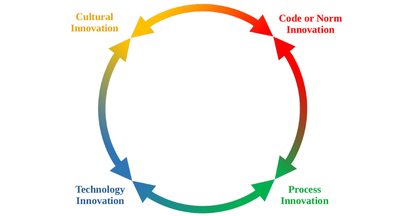Innovation beyond technology: Offering the Innovation Spectrum
Innovation Spectrum Blog 1
PRINZ is interested in how the UK can improve productivity in an inclusive way, while also reaching the non-negotiable target of net zero emissions. Innovation is vital to tackling productivity, but innovation is often read as synonymous with technology, and the challenges that PRINZ is facing up to require innovation on many more fronts than items that can be counted through patent registrations. One of the research challenges therefore is to find a way of categorising innovation in a way that opens up the use of other datasets, as well as representing the complexity of the innovations that will move lives, and the economy, towards net zero.
Is one of the reasons why innovation policy struggles to find ways to support innovation beyond technology because we lack a way of describing those other forms of innovation?
Responding to this challenge, we are aware of the powerful frameworks which help explain and analyse the processes through which innovation arises and spreads. Innovation diffusion theory (Rogers, 2003) helps us reflect on the attributes of innovations that make them more or less likely to be adopted, and what adopter characteristics to attend to as innovations spread. As a theory of socio-technical transition, the multi-level perspective (Geels, 2002, 2005 and much more work) explores the dynamics of innovation, and co-evolutionary framing (e.g. Norgaard 1984) helps us see how systems are interlocked, emphasising that innovation in a single system is insufficient to achieve transformational change. There are discussions of business model innovation (Schneider & Spieth 2013) and explorations of various dimensions such as user involvement (Hippel 1986 or Hippel & Euchner 2013) and resource management (Wernerfelt 1984 & 1995 or Barney 1991 & Barney et al 2011). There are also theories that embrace diverse perspectives on innovation, from systemic (such as Papaioannou et al. 2007 or Asheim et al 2011) to collaborative dimensions (such as Galvagno & Dalli 2014 or Nanonen et al. 2015). All of these serve to illustrate the multifaceted nature of innovation, and the inherent diversity and complexity of innovation as a phenomena.
The bodies of research using these theories is richer than we can explore here, but still we found we needed a simple way of categorising the innovations needed to tackle productivity in tandem with net zero. We needed to categorise innovation, and identify the datasets that will help us understand the use of different forms of innovation, so that policy and practice can develop appropriate responses on multiple fronts. Datasets which capture innovation activity already cover more than the patents that represent one type of technological innovation. For example, the World Management Survey has decades of global data on management innovation and productivity actions from surveys and interview with business and enterprise.

While struggling to structure the innovation phenomena we have observed in sector case studies of sectors, we stumbled upon something rather intriguing: what happens if we consider innovation not as an entity, but as a spectrum? We found that could, empirically, identify four staging posts along this ‘Innovation Spectrum’: Technology Innovation, Process Innovation, Code or Norm Innovation, and Cultural Innovation. The edge of each these categories blends into the next making along a continuum.
We intend to develop these four types in a series of PRINZ blogs.
Our exploration begins with Technology Innovation, where shifts in tools and objects have had pervasive influence across diverse domains. Technological innovation is powerful, but also inter-connected to innovations in other areas. Examples of technology innovation are everywhere – in agriculture, homes, transport, energy generation and manufacturing.
Shifting our gaze to Process Innovation, we think about redesign and implementation of methods or procedures. Beyond technological shifts, process innovation unfolds across diverse sectors, changing how both materials and ideas are handled and transformed.
The journey continues with Code or Norm Innovation; innovations that change institutional “rules of the game”. From legal and ethical norms to industry standards, we explore how changing codes, societal dynamics, and governance structures interact. Societal structures evolve and adapt in response to changing norms and governance frameworks.
Our exploration concludes with Cultural Innovation. From language evolution to sustainability movements, cultural innovations shape domains such as communication, art, technology, cuisine, fashion, and social movements. Cultural innovation emerges from the dynamic interplay between creativity, societal shifts, and the intricate web of human culture.
Join us as we try to decipher the complexities and interconnected nature of the innovations needed to improve productivity, share progress equitably and achieve net zero.